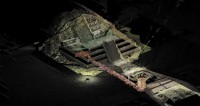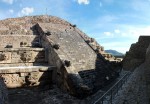 The excavations under the Temple of the Feathered Serpent in Teotihuacan have unearthed another exceptional find: large quantities of liquid mercury. Archaeologist Sergio Gómez and his team have been excavating the tunnel underneath the pre-Aztec pyramid, discovered by accident in 2003 when a sinkhole opened up in front of the temple, since 2009, using a robot to reveal three chambers at the end of the tunnel and last year discovering an enormous cache of 50,000 artifacts (sculptures, jade, rubber balls, obsidian blades, pyrite mirrors) and organic remains (animal bones, fur, plants, seeds, skin). It has taken so long to excavate it because the tunnel was filled to the brim with soil and rocks and sealed 1,800 years ago by the people of Teotihuacan about whom we know very little.
The excavations under the Temple of the Feathered Serpent in Teotihuacan have unearthed another exceptional find: large quantities of liquid mercury. Archaeologist Sergio Gómez and his team have been excavating the tunnel underneath the pre-Aztec pyramid, discovered by accident in 2003 when a sinkhole opened up in front of the temple, since 2009, using a robot to reveal three chambers at the end of the tunnel and last year discovering an enormous cache of 50,000 artifacts (sculptures, jade, rubber balls, obsidian blades, pyrite mirrors) and organic remains (animal bones, fur, plants, seeds, skin). It has taken so long to excavate it because the tunnel was filled to the brim with soil and rocks and sealed 1,800 years ago by the people of Teotihuacan about whom we know very little.
The mercury was found in one of the chambers discovered by the robot at the end of the tunnel.
“It’s something that completely surprised us,” Gomez said at the entrance to the tunnel below Teotihuacan’s Pyramid of the Plumed Serpent, about 30 miles (50 km) northeast of Mexico City.
Some archeologists believe the toxic element could herald what would be the first ruler’s tomb ever found in Teotihuacan, a contemporary of several ancient Maya cities, but so shrouded in mystery that its inhabitants still have no name.
Unsure why the mercury was put there, Gomez says the metal may have been used to symbolize an underworld river or lake.
 Mercuric sulfide is the most commonly found source of mercury ore and ancient Mesoamericans were intimately familiar with it both as a red pigment and for its mercury content. They knew how to extract mercury from crushed cinnabar — heating the ore separates the mercury from sulfur and the evaporated mercury can then be collected in a condensing column — and employed it as a gilding medium and possibly for ritual purposes. It was very difficult and dangerous to produce. Before now, traces of mercury have only been found at a two Maya sites and one Olmec site in Central America. This is the first time it has been discovered in Teotihuacan, and I suspect this is the first time it has been discovered in large amounts anywhere in ancient Mexico. (The exact quantities discovered under the Temple of the Feathered Serpent and at the other sites haven’t been reported.)
Mercuric sulfide is the most commonly found source of mercury ore and ancient Mesoamericans were intimately familiar with it both as a red pigment and for its mercury content. They knew how to extract mercury from crushed cinnabar — heating the ore separates the mercury from sulfur and the evaporated mercury can then be collected in a condensing column — and employed it as a gilding medium and possibly for ritual purposes. It was very difficult and dangerous to produce. Before now, traces of mercury have only been found at a two Maya sites and one Olmec site in Central America. This is the first time it has been discovered in Teotihuacan, and I suspect this is the first time it has been discovered in large amounts anywhere in ancient Mexico. (The exact quantities discovered under the Temple of the Feathered Serpent and at the other sites haven’t been reported.)
 Reflective materials held a great deal of religious significance in Mesoamerican cultures. Mirrors were seen as conduits to the supernatural. A river of mercury would make one hugely expensive and ritually important conveyance to the underworld. Added to the exceptional finds already made in the tunnel, the presence of so much mercury indicates that if anybody was buried in these chambers, it would have to be someone of enormous importance in Teotihuacan society. It could be a king, but we don’t know what kind of governing system they had in Teotihuacan, so it could be a lord, several oligarchs or religious leaders. The hope is that this excavation and its unprecedented finds will answer many of the long-outstanding questions about the city of Teotihuacan.
Reflective materials held a great deal of religious significance in Mesoamerican cultures. Mirrors were seen as conduits to the supernatural. A river of mercury would make one hugely expensive and ritually important conveyance to the underworld. Added to the exceptional finds already made in the tunnel, the presence of so much mercury indicates that if anybody was buried in these chambers, it would have to be someone of enormous importance in Teotihuacan society. It could be a king, but we don’t know what kind of governing system they had in Teotihuacan, so it could be a lord, several oligarchs or religious leaders. The hope is that this excavation and its unprecedented finds will answer many of the long-outstanding questions about the city of Teotihuacan.
I’m excited about this discovery because I’ve been fascinated by the notion of underground rivers of mercury since I first read about the ones reportedly created for the tomb of the first Emperor of China Qin Shi Huang. Better known today for the terracotta army found in pits around the emperor’s burial mound, the mausoleum itself was apparently a thing of shimmering splendour. Grand Historian to the Han emperor Sima Qian, writing a century after the Qin emperor’s death, described Qin Shi Huang’s mausoleum in Volume Six of the Shiji (Records of the Grand Historian), China’s first official dynastic history.
They dug down deep to underground springs, pouring copper to place the outer casing of the coffin. Palaces and viewing towers housing a hundred officials were built and filled with treasures and rare artifacts. Workmen were instructed to make automatic crossbows primed to shoot at intruders. Mercury was used to simulate the hundred rivers, the Yangtze and Yellow River, and the great sea, and set to flow mechanically. Above, the heaven is depicted, below, the geographical features of the land.
As the emperor’s burial mound has not been excavated (just the environs), we don’t know if the rivers of flowing mercury really existed, but high levels of mercury have been found in soil samples taken from the tumulus so significant amounts of the heavy metal were certainly used for some purpose. I think it would be the coolest thing if the people of Teotihuacan created their own shimmering splendor of an underworld too.